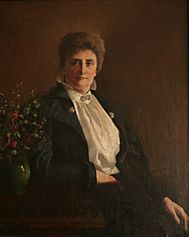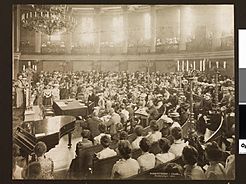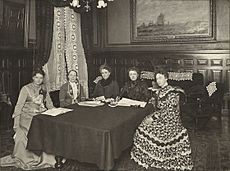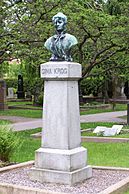Gina Krog facts for kids
Quick facts for kids
Gina Krog
|
|
|---|---|

Gina Krog
|
|
| Born |
Jørgine Anna Sverdrup Krog
20 June 1847 Flakstad, United Kingdoms of Sweden and Norway
|
| Died | 14 April 1916 (aged 68) |
| Burial place | Vår Frelsers gravlund |
| Nationality | Norwegian |
| Occupation | Editor, teacher and suffragist |
| Years active | 1880–1916 |
| Organization | Norwegian Association for Women's Rights, Women's Voting Association, National Association for Women's Suffrage, and Norwegian National Women's Council |
| Known for | Feminist pioneer |
| Political party | Liberal Party |
| Movement | Women's suffrage |
| Relatives |
|
Jørgine Anna Sverdrup "Gina" Krog (born June 20, 1847 – died April 14, 1916) was a brave Norwegian woman. She was a teacher, writer, and editor. Most importantly, she fought for women's right to vote. People who fight for the right to vote are called suffragists.
Gina was a key leader in the women's movement in Norway. She worked hard to get women the same rights as men, especially the right to vote. In 1884, she helped start the Norwegian Association for Women's Rights. Over the next 20 years, she also helped create other important groups. These groups included the Women's Voting Association and the National Association for Women's Suffrage. They worked to bring ideas about women's voting rights to the Storting, which is Norway's parliament.
Gina Krog wrote articles and gave many speeches. She traveled across Europe and North America to attend meetings about women's rights. From 1887 until she died, she was the editor of a Norwegian magazine called Nylænde (New Land). She was also an early member of the Liberal Party. Gina was inspired by American women's rights leaders like Susan B. Anthony and Elizabeth Cady Stanton.
Gina Krog believed that all women should have the right to vote, just like men. In her time, these ideas were seen as very modern and bold. She sometimes disagreed with other women's rights activists who wanted to start by giving only some women the right to vote. In 1910, Norwegian women gained the right to vote in local elections. By 1913, all women in Norway could vote in national elections too.
Gina Krog was the first woman in Norway to have a state funeral. This means the government paid for her funeral to honor her. Since 2009, the Norwegian Association for Women's Rights has given out the Gina Krog Prize. This award honors people who work to support women's rights.
Contents
Early Life and Education

Jørgine Anna Sverdrup Krog was born on June 20, 1847. Her birthplace was Flakstad, in a beautiful area called Lofoten. Her father was a priest named Jørgen Sverdrup Krog. Her mother was Ingeborg Anna Dass Brinchmann. Sadly, Gina's father died when she was very young.
Gina lived with her mother in Karmøy until she was eight years old. Then, they moved to Oslo, which was called Christiania back then. In Christiania, Gina went to a school for girls.
As a young adult, Gina worked as a teacher in private schools. She spent many years teaching. She also continued to learn on her own. She studied languages and literature to improve her knowledge. Gina never married. She was known for being one of the first women to go hiking in the mountains of Jotunheimen. This earned her the nickname "mountaineer."
Fighting for Women's Rights
In 1880, Gina Krog stopped teaching for good. She decided to dedicate her life to fighting for women's rights. She traveled to Great Britain and stayed at Bedford College. There, she met leaders of the British women's voting movement, like Millicent Garrett Fawcett.
While in Britain, Gina wrote articles for Norwegian newspapers. At first, she used different names so people wouldn't know it was her. Her time in Britain helped her develop strong ideas about women's rights. Unlike some others who focused on improving women's jobs, Gina wanted full political rights for women. She believed women should have the right to vote under the same rules as men. She argued that anyone who paid taxes and was a good citizen should have the same freedoms.
Starting Women's Groups
When Gina returned to Norway in 1883, she helped start the first Norwegian women's business club. The next year, she took part in a public debate about women's rights. This was one of the first times a Norwegian woman spoke in such a debate.
In 1884, Gina Krog helped create the Norwegian Association for Women's Rights. She started it with Hagbard Emanuel Berner, who was a member of parliament. The group quickly gained 220 members, both women and men. They decided to focus on women's education, work benefits, and marriage rights. However, Gina wanted the group to fight for equal voting rights for women. This led to disagreements between her and Berner.

In 1884, Gina wrote articles urging women to take on more leadership roles. The next year, she gave a talk called "Voting for Women." Berner disagreed with her so much that he resigned as chairman. Despite these disagreements, Gina edited the association's magazine, Nylænde, from 1887 until she died.
In December 1885, Gina Krog helped start the Women's Voting Association. She started it with nine other women from the Association for Women's Rights. These women included Ragna Nielsen and Anna Rogstad. Gina led this new association from 1885 to 1897. She was inspired by a book about the history of women's voting rights sent by American activist Susan B. Anthony. The Women's Voting Association only allowed women members. They believed women should be responsible for achieving their own political equality.
Pushing for the Vote
The Women's Voting Association worked hard, but their first ideas for women's voting rights were not successful. In 1886, they sent the first proposal for women's voting rights to the Storting. But in 1890, the parliament rejected it. Lawmakers voted 114 to 44 against it.
After this, some members of the Women's Voting Association decided to change their goal. They wanted to fight only for women's right to vote in local elections. Gina Krog refused to agree to this plan. In 1893, a new proposal for women's voting rights was sent to the Storting. More than half of the parliament members supported it, but it needed two-thirds support to change the constitution.
During the 1890s, many politicians who had supported women's voting rights changed their minds. They worried that women would vote for conservative candidates. Even so, the women's movement had some smaller wins. Women were allowed to join school boards and child welfare boards.
In 1896, Norwegian lawmakers gave voting rights to all men who paid taxes. But they still did not give voting rights to women. Two years later, all men received the right to vote.

Disagreements continued within the Women's Voting Association. All the members were middle-class women. This affected their views on whether all women should get the vote. Some, like Gina, wanted all women to vote. But most wanted only women who owned property to vote. Gina believed that women must fight for full voting rights "on the same conditions as men," no matter their social class.
In 1897, Gina Krog left the Women's Voting Association. She then started a new group called the National Association for Women's Suffrage. She started it with another women's rights activist, Fredrikke Marie Qvam.
International Work and Success
In 1899, Gina Krog attended a meeting of the International Council of Women in London, England. She was named an honorary vice-president, representing Norway. Gina then worked to create a Norwegian branch of this international council.
After much effort, the Norwegian government gave limited voting rights to women in 1901. Women who owned property, or whose husbands owned property, could now vote in local elections. In 1904, Gina's National Association for Women's Suffrage joined the International Woman Suffrage Alliance.

In 1904, Gina Krog founded the Norwegian National Women's Council. This was the Norwegian branch of the International Council of Women. This group was very active the next year when Norway voted to separate from Sweden. The Norwegian National Women's Council supported Norway's independence. They handed out brochures to encourage it.
Only men were allowed to vote in this decision. But women wanted to take part. On August 13, 1905, the day of the vote, Gina Krog led women from major Norwegian women's groups into the Storting building. They told the government that thousands of Norwegian women wanted to approve the separation. The women had organized a nationwide poll among women. They later presented a petition with 300,000 names. This event impressed the parliament members. It helped lead to serious talks about giving women the right to vote.
By 1906, the National Association for Women's Suffrage had grown. It had 40 local groups and 2500 members across Norway. The group was now better able to talk to politicians all over the country.
Gina Krog was part of the official Norwegian group sent to Amsterdam in 1908. This was for the Fourth Conference of the International Woman Suffrage Alliance. She was an early member of the Norwegian Liberal Party. In 1909, she was chosen as a deputy member of its national board. Gina also visited Toronto, Canada, for an International Council of Women meeting. After that, she toured the United States. She gave speeches about the women's voting movement in Norway. That same year, Gina's friend and fellow activist Anna Rogstad became the first female member of the Storting.
In 1910, Norwegian women finally gained the right to vote in local elections. Then, in 1913, the Storting voted unanimously to give all women the right to vote in national elections.
Death and Legacy
Gina Krog died on April 14, 1916, during a flu outbreak. She was the first woman in Norway to be honored with a funeral paid for by the government. Several women who had graduated from university formed a guard of honor. A famous singer, Bergljot Bjørnson, sang at the funeral. Important people attended, including the Prime Minister and the Chief Justice of the Supreme Court.
A bronze statue of Gina Krog was made in 1919 by Ambrosia Tønnesen. It is at her grave in Vår Frelsers gravlund in Oslo.
Streets are named after Gina Krog in Trondheim and Oslo. The Gina Krog Prize is also named in her honor. This prize is given to Norwegian women who work to promote women's rights.
On March 8, 2013, the Norwegian Ministry of Petroleum and Energy announced something special. An oil field called Dagny would be renamed Gina Krog to honor her.
See also
 In Spanish: Gina Krog para niños
In Spanish: Gina Krog para niños
Images for kids
-
Carte de visite of Gina Krog, around 1873.
-
Gina Krog, painted by Asta Nørregaard.
-
Gina Krog and Fredrikke Marie Qvam at a Nordic Women's Congress in Oslo (1902)
-
Norwegian National Women's Council members, from left: Karen Grude Koht, Fredrikke Marie Qvam, Gina Krog, Betzy Kjelsberg and Katti Anker Møller (1904)








